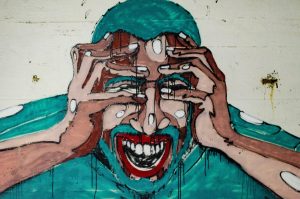MODULE 9: ANXIETY
ANXIETY
This module aligns with key elements of APNA’s “Growth & Development” and “Clinical Decision Making” (American Psychiatric Nurses Association Education Council, Undergraduate Branch, 2022).
Module Outline
- Assessment of Anxiety Disorders
- Nursing Diagnoses Associated with Anxiety Disorders
- Treatment of Anxiety Disorders
Module Learning Outcomes
- Describe the signs and symptoms of anxiety disorders.
- Identify the common nursing diagnoses associated with anxiety disorders.
- Summarize the treatment of anxiety disorders.
Concepts
- Stress
- Safety
- Coping
- Legal and Ethical Issues
Anxiety Disorders
The hallmark symptoms of anxiety-related disorders are excessive fear or worry related to behavioral disturbances. Fear is an adaptive response, as it often prepares your body for an impending threat. Anxiety, however, is more difficult to identify as it is often the response to a vague sense of threat. Anxiety can range from mild to moderate, to severe, and panic. In fact, mild anxiety can act as a motivator to prepare for an anticipated event (e.g., prepare for an upcoming test or job interview). A person with higher stages of anxiety such as severe and panic would need immediate intervention. It is important to recognize anxiety can occur with both positive or negative situations. For example, buying a house, graduating, having a baby, getting married are examples of events that are generally considered positive and associated with feelings of happiness and excitement, yet they may also induce feelings of stress and anxiety.
As you will see throughout the chapter, individuals may experience anxiety in many different forms. Generalized anxiety disorder, (GAD) the most common of the anxiety disorders, is characterized by a global and persistent feeling of anxiety. A specific phobia is observed when an individual experiences anxiety related to a specific object or subject. Similarly, an individual may experience agoraphobia when they feel fear specific to leaving their home and traveling to public places. Social anxiety disorder occurs when an individual experiences anxiety related to social or performance situations, where there is the possibility of being evaluated negatively. And finally, there is panic disorder, where an individual experiences recurrent panic attacks consisting of physical and cognitive symptoms.
Below is an overview of a nurse’s consideration for the assessment, problems, and treatment of anxiety.
Assessment
Signs and symptoms of anxiety vary widely. These symptoms can generally be categorized into four categories: mood, behavioral, cognitive, and physical symptoms. In general, anxiety can be caused by the interaction of various biopsychosocial factors (Chand, Marwaha, et al., 2022). Therefore, it is important to perform a comprehensive assessment and consider potential contributors to the individual’s anxiety.
Mood
Mood may be nervous, tense, fearful, edgy, impatient, and/or frustrated (Chand, Marwaha, et al., 2022).
Behavioral
Individuals who are anxious may avoid certain situations, pursue a sense of safety, and/or exhibit various external characteristics such as restlessness, agitation, pacing, hyperventilation, appear motionless, and difficulty speaking (Chand, Marwaha, et al., 2022).
Cognitive
Cognitive symptoms may include fears of losing control, physical injury, death, or negative evaluation by others (Chand, Marwaha, et al., 2022). Individuals with anxiety may also have frightening thoughts, mental images, or memories (Chand, Marwaha, et al., 2022). They may have poor concentration, confusion, narrowed attention, and difficulty speaking (Chand, Marwaha, et al., 2022). Individuals may also find themselves ruminating over a situation, an interaction, or an upcoming event. Watch the video below for an intervention to combat rumination.
University of York. (2019). Breaking the wall of ruminative anxious thought [Video]. YouTube. https://youtube.com/watch?v=AD_Ay-mwLoc&si=EnSIkaIECMiOmarE
Physical
Physiological symptoms associated with anxiety are increased heart rate, palpitations, shortness of breath, tachypnea, chest pain/pressure, diaphoresis, Gastrointestinal (GI) disturbances (e.g., nausea, upset stomach, diarrhea), trembling, weakness, faintness, rigidity, and dry mouth (Chand, Marwaha, et al., 2022). Essentially, anxiety activates the body’s stress response (i.e., the sympathetic nervous system also known as the fight or flight system).
Instruments
The Generalized Anxiety Disorder Screener-7 (GAD-7) can be used to assess anxiety issues (Rhoads, 2021).
Problems
Problems commonly associated with an Anxiety diagnosis are:
-
Inadequate management of mood and behavior
-
Deficient knowledge
-
Inadequate social skills
- Imbalance in social functioning (Chand, Marwaha, et al., 2022)
Treatment
Recall from MODULE 4: PSYCHOPHARMACOLOGY Anxiolytics are the psychotropic class used to treat anxiety. Within that class, Benzodiazepines can be used for a situation requiring immediate pharmacological intervention. However, due to the tolerance and dependence associated with Benzodiazepines, this class is not ideal for the long-term treatment of anxiety. Selective serotonin-reuptake inhibitors (SSRIs) and serotonin-norepinephrine reuptake inhibitors (SNRIs) are generally considered to be first-line medication options for those with GAD. Unfortunately, none of these medications continue to provide any benefit once they are stopped; therefore, other effective treatment options such as Cognitive Behavior Therapy, relaxation training, and biofeedback are often encouraged before the use of pharmacological interventions.
Level Up RN. (2022). Stress and general adaption syndrome, anxiety-psychiatric mental health nursing [Video]. YouTube. https://youtube.com/watch?v=s86DDGAqkS4&si=EnSIkaIECMiOmarE
Mental Health Promotion
There are various ways to promote mental health and well-being. Long-term treatment for anxiety should include mental health promotion approaches.
Some specific strategies to promote mental health related to an Anxiety diagosis discussed in Videbeck (2020) include:
- Express thoughts and feelings
- Practice relaxation techniques such as deep breathing and meditation
- Exercise regularly
- Ensure plenty of rest and sleep
- Create realistic goals and expectations.
Visit the MODULE 5-MENTAL HEALTH PROMOTION chapter to learn more about this topic.
Key Takeaways and Concept Map Activity
You should have learned the following in this section:
- All anxiety disorders share the hallmark symptoms of excessive fear or worry related to behavioral disturbances.
- Treatment options include benzodiazepines, CBT, and biofeedback.
Concept Map Activity
- Create a concept map that depicts the assessment and treatment of Anxiety.
- If needed, see the INTRODUCTION for a concept map tutorial.
Adapted from Fundamentals of Psychological Disorders 2nd Edition- Module 7 by Alexis Bridley, Ph.D. and Lee W. Daffin Jr., Ph.D. licensed under a Creative Commons Attribution 4.0 International License. Modifications: revised for clarity and flow ![]() .
.
To ruminate is to think of something over and over.
Check out Dr. Tracey Marks' video



